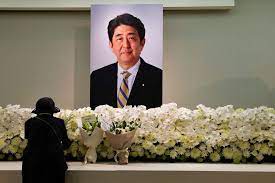The mental fitness examination of former Prime Minister Shinzo Abe’s killer will continue until Feb. 6 instead of Nov. 29, as originally scheduled, Japanese media reported on Thursday.
The Kyodo news agency said, citing prosecutors, that the court granted their request that 42-year-old Tetsuya Yamagami remains in custody for the entire period of the checks. It did not specify the reasons.
Japanese law reduces the penalty for criminals with insanity.
In July, the Nara District Court granted the prosecution’s request for Yamagami to undergo medical checks, including regarding his mental state.
The man was placed in the Osaka Detention Center to undergo the procedure.
Abe, 67, was attacked on July 8 in the Japanese city of Nara while he was giving a campaign speech.
Yamagami approached the politician from behind and fired two shots from a distance of about 10 meters (33 feet) using a homemade gun.
The attacker told investigators that he decided to carry out the assassination because of Abe’s alleged ties to a religious sect that he claimed had bankrupted his mother.
The group has denied having had anything to do with the former prime minister.
The homemade gun used in the shooting of the former prime minister apparently employed an electrical charge to ignite homemade gunpowder that would then fire off a volley of conventional ammunition.
Nara prefectural police believe Tetsuya Yamagami, 41, the murder suspect, used commercially available bullets with his homemade gun.
The gun was seized at the scene where Abe was shot while delivering a campaign speech in front of the Kintetsu Line’s Yamato-Saidaiji Station on July 8.
The homemade gun, measuring 40 centimeters long and 20 cm high, has two barrels and shoots six bullets at a time, police said.
A small battery was equipped under the two loaded barrels, investigative sources said.
The batteries were connected to the homemade gunpowder with electrically conductive lead.
Police believe that Yamagami activated the batteries to transmit electricity to the gunpowder to ignite it.
The size of each of the six shots was about 5 millimeters to 1 cm in diameter.
Police searched Yamagami’s home and confiscated five homemade guns.
Police also found two guns in the works. All of the seven guns resemble the homemade gun seized at the shooting scene.
Yamagami told investigators that he started making guns last year and had learned how to make them from YouTube instructional videos, according to sources.
Yamagami told police he tested these guns “in the mountains” more than 10 times, sources said.
Police have searched various sites based on his statements and have found wooden boards with holes, along with concrete blocks, metallic barrels, and plastic pieces that appear to be parts of shell casings.
Yamagami made many prototypes and tested them to produce a gun with highly lethal force, police said.
Police also said Yamagami rented a garage with a shutter in Nara Prefecture from around November 2021 to February this year.
Yamagami told investigators he used the garage to “dry homemade gunpowder,” police said.
Meanwhile, an uncle to the suspected killer of the former prime minister told reporters on July 15 that Yamagami attempted suicide 17 years ago.
The uncle said that Yamagami’s suicide attempt was so that his siblings could get a life insurance payout, as the family had been struggling financially due to his mother’s huge donation to a religious group.
The suspect’s 77-year-old uncle spoke to reporters a week after the assassination.
The uncle said that Yamagami was dogged by the thought that his “life was a mess” because of the Unification Church. (Sputnik/NAN)


